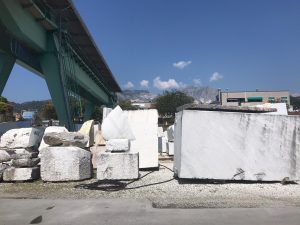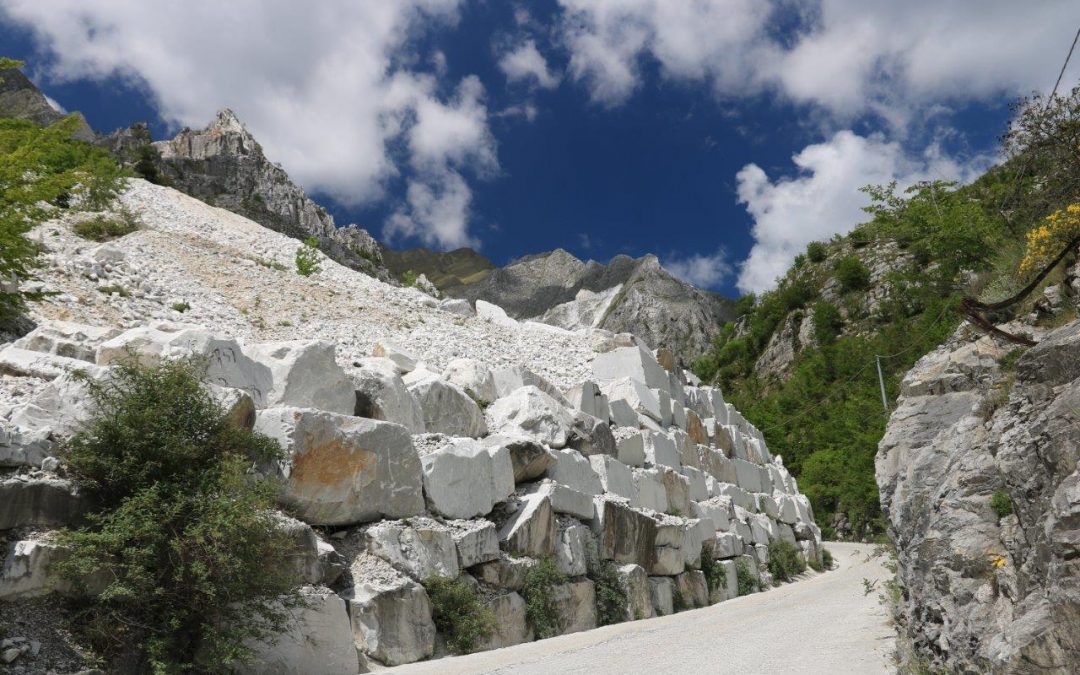For the past two decades, spending some part of August in Italy has been a family tradition. This wasn’t just a travel-inspired indulgence, but a means of connecting with friends and relatives from our former homeland, and of course, anticipating the upcoming tile and stone trends for the following year. Yet this year, tradition took a hiatus. Although I’m not writing from Italy today, my heart somehow made its way there and inspired my August 2020
Intentional Spaces blog.
I dedicate today’s post to a special place in Tuscany, nestled along the Carrione River in the province of Massa. This town may sound like some faraway land, but a piece of it has probably made its way into your own home. Perhaps it sits as an inconspicuous threshold at your doorstep, or adorns a shelf in your shower. The town to which I’m referring is Carrara, a landmark in Italy known for its riverside quarries and ancient Latin motto.

Inscribed in the walls of Carrara are the words, “Fortitudo mea in rota,” meaning “my strength is in the wheel.” The “rota,” or wheel, holds deep roots in the culture of Carrara. The wheel was the original system of transport that allowed formerly unattainable pieces of Carrara marble to be moved from the precarious peaks of the Apuan Alps all the way down to sea level. The chunks of mountain could then be fabricated into what now resides in homes all over the planet, likely including yours and mine.
The Carrara quarries have produced more marble than any other place on Earth. What’s in store for Carrara, and always has been, is quite literally marble. Store parking lots, median strips, supermarkets, and even the gravel roads around Carrara are all made of pure Carrara marble. Things as mundane as street gravel or a parking lot may go unnoticed, but great risk and courage were required to create all the structures in and around Carrara. Most of us don’t consider the perilous work of quarrying marble from such an intricate mountainous landscape. You can see the chunks cut out of the mountainside in this photo above, kindly provided by my Tuscan friend
Elia Nichols on a recent family trip to Carrara.
Over the last couple millennia, Carrara eventually weaved its way into our homes; if not as an elegant shower surround, then as a bathroom door threshold. Next time you step over one, take a moment to consider the innovation and sacrifice it took to get that tiny fragment from the Italian Alps into your home. Consider what transpired to get it there; the invention of the wheel, the courage to climb the mountain and carry that first piece of stone down with nothing but a rickety cart and a couple rudimentary wheels.

It’s unknown how long ago that was, but it’s believed that some Carrara marble was extracted even before the Roman times. Since the 5th century B.C., it was used to build Italian monuments and works of art. My personal favorite is Michelangelo’s iconic statue of David, housed in my beloved former home of Florence. The true brilliance of Carrara marble is that, despite its ancient history, it continues to live on today as one of the most popular finishes in the tile industry. It’s transcended many civilizations and pandemics.
Carrara is one of the most prevalent marbles we’ve installed over my last two decades in the tile industry. It still prevails among 2020’s hottest marble and tile trends. The longevity of Carrara as an artistic medium lies in its capacity to be transformed into modern styles while maintaining its classic Italian integrity.
This is a year for dynamic changes in the tile industry. This Spring at
Coverings 2020, the tile industry’s premier trade show, we got to witness a glance of a new era of marble tiles emerging. Carrara is taking on exciting shapes and forms this year, unlike anything we’ve seen recently. The tile industry has moved from the rectangular and mundane toward much more dramatic shapes. We can gear up for mixed geometrics like trapezoid, rhombus, and diamond-shaped creations. The simple grids and running bonds of the past are giving way to a post-pandemic wild side.
The wheel of fortune that describes Carrara has long been a metaphor for the unpredictable nature of fate. As we spend this year as hostages to the fate of a global pandemic, it’s important to find gratitude for what we do have. As you sit at home, remember to take a moment to simply observe the walls around you. Notice all the finishes that adorn the place you call home. Consider the labor and sacrifice behind each piece of it. Take time to find gratitude for the technology, courage, and wisdom that went into the materials in your home. Today, although I long for my typical August in Italy, I’m forever grateful for the pieces of it in my home. Grazie Italia!
 Inscribed in the walls of Carrara are the words, “Fortitudo mea in rota,” meaning “my strength is in the wheel.” The “rota,” or wheel, holds deep roots in the culture of Carrara. The wheel was the original system of transport that allowed formerly unattainable pieces of Carrara marble to be moved from the precarious peaks of the Apuan Alps all the way down to sea level. The chunks of mountain could then be fabricated into what now resides in homes all over the planet, likely including yours and mine.
The Carrara quarries have produced more marble than any other place on Earth. What’s in store for Carrara, and always has been, is quite literally marble. Store parking lots, median strips, supermarkets, and even the gravel roads around Carrara are all made of pure Carrara marble. Things as mundane as street gravel or a parking lot may go unnoticed, but great risk and courage were required to create all the structures in and around Carrara. Most of us don’t consider the perilous work of quarrying marble from such an intricate mountainous landscape. You can see the chunks cut out of the mountainside in this photo above, kindly provided by my Tuscan friend Elia Nichols on a recent family trip to Carrara.
Over the last couple millennia, Carrara eventually weaved its way into our homes; if not as an elegant shower surround, then as a bathroom door threshold. Next time you step over one, take a moment to consider the innovation and sacrifice it took to get that tiny fragment from the Italian Alps into your home. Consider what transpired to get it there; the invention of the wheel, the courage to climb the mountain and carry that first piece of stone down with nothing but a rickety cart and a couple rudimentary wheels.
Inscribed in the walls of Carrara are the words, “Fortitudo mea in rota,” meaning “my strength is in the wheel.” The “rota,” or wheel, holds deep roots in the culture of Carrara. The wheel was the original system of transport that allowed formerly unattainable pieces of Carrara marble to be moved from the precarious peaks of the Apuan Alps all the way down to sea level. The chunks of mountain could then be fabricated into what now resides in homes all over the planet, likely including yours and mine.
The Carrara quarries have produced more marble than any other place on Earth. What’s in store for Carrara, and always has been, is quite literally marble. Store parking lots, median strips, supermarkets, and even the gravel roads around Carrara are all made of pure Carrara marble. Things as mundane as street gravel or a parking lot may go unnoticed, but great risk and courage were required to create all the structures in and around Carrara. Most of us don’t consider the perilous work of quarrying marble from such an intricate mountainous landscape. You can see the chunks cut out of the mountainside in this photo above, kindly provided by my Tuscan friend Elia Nichols on a recent family trip to Carrara.
Over the last couple millennia, Carrara eventually weaved its way into our homes; if not as an elegant shower surround, then as a bathroom door threshold. Next time you step over one, take a moment to consider the innovation and sacrifice it took to get that tiny fragment from the Italian Alps into your home. Consider what transpired to get it there; the invention of the wheel, the courage to climb the mountain and carry that first piece of stone down with nothing but a rickety cart and a couple rudimentary wheels.
 It’s unknown how long ago that was, but it’s believed that some Carrara marble was extracted even before the Roman times. Since the 5th century B.C., it was used to build Italian monuments and works of art. My personal favorite is Michelangelo’s iconic statue of David, housed in my beloved former home of Florence. The true brilliance of Carrara marble is that, despite its ancient history, it continues to live on today as one of the most popular finishes in the tile industry. It’s transcended many civilizations and pandemics.
Carrara is one of the most prevalent marbles we’ve installed over my last two decades in the tile industry. It still prevails among 2020’s hottest marble and tile trends. The longevity of Carrara as an artistic medium lies in its capacity to be transformed into modern styles while maintaining its classic Italian integrity.
This is a year for dynamic changes in the tile industry. This Spring at Coverings 2020, the tile industry’s premier trade show, we got to witness a glance of a new era of marble tiles emerging. Carrara is taking on exciting shapes and forms this year, unlike anything we’ve seen recently. The tile industry has moved from the rectangular and mundane toward much more dramatic shapes. We can gear up for mixed geometrics like trapezoid, rhombus, and diamond-shaped creations. The simple grids and running bonds of the past are giving way to a post-pandemic wild side.
The wheel of fortune that describes Carrara has long been a metaphor for the unpredictable nature of fate. As we spend this year as hostages to the fate of a global pandemic, it’s important to find gratitude for what we do have. As you sit at home, remember to take a moment to simply observe the walls around you. Notice all the finishes that adorn the place you call home. Consider the labor and sacrifice behind each piece of it. Take time to find gratitude for the technology, courage, and wisdom that went into the materials in your home. Today, although I long for my typical August in Italy, I’m forever grateful for the pieces of it in my home. Grazie Italia!
It’s unknown how long ago that was, but it’s believed that some Carrara marble was extracted even before the Roman times. Since the 5th century B.C., it was used to build Italian monuments and works of art. My personal favorite is Michelangelo’s iconic statue of David, housed in my beloved former home of Florence. The true brilliance of Carrara marble is that, despite its ancient history, it continues to live on today as one of the most popular finishes in the tile industry. It’s transcended many civilizations and pandemics.
Carrara is one of the most prevalent marbles we’ve installed over my last two decades in the tile industry. It still prevails among 2020’s hottest marble and tile trends. The longevity of Carrara as an artistic medium lies in its capacity to be transformed into modern styles while maintaining its classic Italian integrity.
This is a year for dynamic changes in the tile industry. This Spring at Coverings 2020, the tile industry’s premier trade show, we got to witness a glance of a new era of marble tiles emerging. Carrara is taking on exciting shapes and forms this year, unlike anything we’ve seen recently. The tile industry has moved from the rectangular and mundane toward much more dramatic shapes. We can gear up for mixed geometrics like trapezoid, rhombus, and diamond-shaped creations. The simple grids and running bonds of the past are giving way to a post-pandemic wild side.
The wheel of fortune that describes Carrara has long been a metaphor for the unpredictable nature of fate. As we spend this year as hostages to the fate of a global pandemic, it’s important to find gratitude for what we do have. As you sit at home, remember to take a moment to simply observe the walls around you. Notice all the finishes that adorn the place you call home. Consider the labor and sacrifice behind each piece of it. Take time to find gratitude for the technology, courage, and wisdom that went into the materials in your home. Today, although I long for my typical August in Italy, I’m forever grateful for the pieces of it in my home. Grazie Italia!






What a beautiful tribute! Thank you for sharing this! I am the creator of the tour in which Elia Nichols took these photos. It has been a pleasure for me the past 7 years to share a hands-on experience to show guests from the beginning to the end what it takes to create a masterpiece like the David. It’s an experience that many describe as “Awe inspiring”, “Life changing”, a “Once-in-a-lifetime experience” and changes their perspective to never look at a statue the same again.
Guests can contact me through my site to arrange a private tour. europavita.us
Fabulous! Thanks so much for sharing! We’ll definitely reach out to you on our next trip to Tuscany! Hopefully soon!
Very nice and informative post Gianna. Please keep sharing more about it. I am bookmarking your blog for the future.
Thank you so much for your comment and interest! I apologize for not responding sooner. New blog post to come soon!